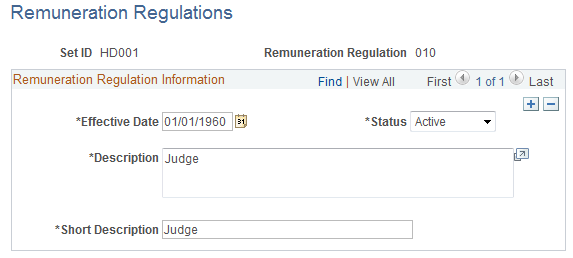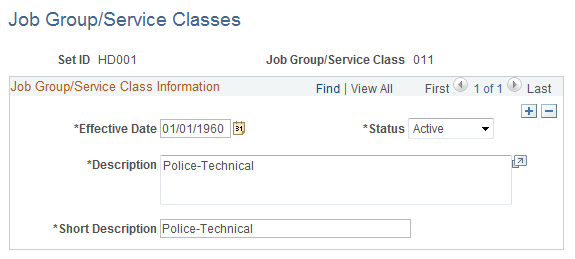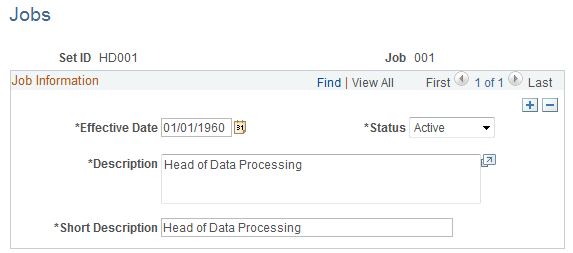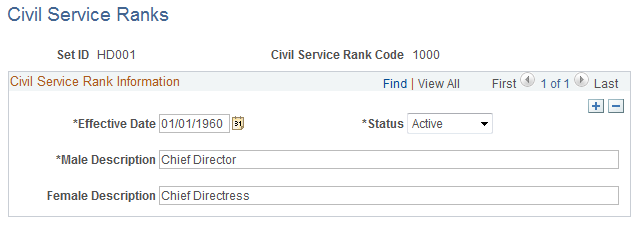Setting Up German Public Sector Workforce Data Tables
To set up German Public Sector workforce data tables, use the Remuneration Regulations (GPS_REMUN_REG), Job Group/Service Classes (GPS_JG_SC), Jobs (GPS_JG_JOB), Civil Service Ranks (GPS_CSR_CODES), and Municipality Table (GPS_MUNICIP_TBL) components.
This section discusses how to set up German Public Sector workforce data tables.
|
Page Name |
Definition Name |
Usage |
|---|---|---|
|
GPS_REMUN_REG |
Define remuneration regulations. Remuneration regulations are components that further detail the compensation structure of the labor agreements for different employee categories. |
|
|
GPS_JG_SC |
Define job groups and service classes for your employees. |
|
|
GPS_JG_JOB |
Create jobs for a BAT (Bundesangestelltentarif) labor agreement. |
|
|
GPS_CSR_CODES |
Define civil service ranks. |
|
|
GPS_MUNICIP_TBL |
Define municipality codes (Amtlicher Gemeindeschlüssel) for workforce statistical reporting. |
Use the Remuneration Regulations page (GPS_REMUN_REG) to define remuneration regulations.
Remuneration regulations are components that further detail the compensation structure of the labor agreements for different employee categories.
Navigation
Image: Remuneration Regulations page
This example illustrates the fields and controls on the Remuneration Regulations page.

You can assign different remuneration regulations for labor agreements for different employee categories. The mapping of the remuneration regulation is defined on the Employee Categorization page.
Retirement is based upon the remuneration regulation and service class group. To enter retirement information for a remuneration regulation, use the Job Group/Service Class Information page to define retirement ages. The minimum age and maximum age are stored by service class group. When you enter an action of RET (Retirement) in the worker’s Job Data, the system validates this information to ensure that the individual qualifies for retirement.
See Defining Employee Categories for Labor Agreements and Job Group/Service Class Information Page.
Use the Job Group/Service Classes page (GPS_JG_SC) to define job groups and service classes for your employees.
Navigation
Image: Job Group/Service Classes page
This example illustrates the fields and controls on the Job Group/Service Classes page.

Remuneration regulations are composed of different job groups and service classes.
Note: A job group is the description for white and blue collar workers. A service class is the description for all civil servants. Job groups are unique to each type of remuneration regulation.
You will map the job group and service class to remuneration regulations on the Job Group/Service Class Information page when you set up employee categories.
Use the Jobs page (GPS_JG_JOB) to create jobs for a BAT (Bundesangestelltentarif) labor agreement.
Navigation
Image: Jobs page
This example illustrates the fields and controls on the Jobs page.

The jobs you create in this component are available for the BAT (Bundesangestelltentarif) labor agreement and are for white collar workers only. They are not available for other labor agreements.
You will map jobs to remuneration regulations within employee categories for a labor agreement on the Job Group/Service Class Information page.
Use the Civil Service Ranks page (GPS_CSR_CODES) to define civil service ranks.
Navigation
Image: Civil Service Ranks page
This example illustrates the fields and controls on the Civil Service Ranks page.

The civil service ranking is a vital part of a GPS civil servant’s professional status as well as prominently used in an individual’s personal life.
The civil service rank for the salary grade is dependent upon the employee category, job group/service class and service class group and should be set up prior to creating employee categories.
Note: When accessing the Civil Service Ranks component, the search page will display the Set ID, Civil Service Rank Code, and Male Description fields for searching.
|
Field or Control |
Definition |
|---|---|
| Civil Service Rank Code |
Enter a code for the civil service rank. You can use up to 15 characters. This field is required. |
| Male Description |
Enter a male oriented description for the civil service rank. You can use up to 120 characters. |
| Female Description |
Enter a female oriented description for the civil service rank. You can use up to 120 characters. |
Use the Municipality Table page (GPS_MUNICIP_TBL) to define municipality codes (Amtlicher Gemeindeschlüssel) for workforce statistical reporting.
Navigation
Image: Municipality Table page
This example illustrates the fields and controls on the Municipality Table page.

Use this page to define you municipality codes. Municipality codes can be associated with a location. It is also used for workforce statistics in tracking family allowance.
Note: We recommend that you populate the Municipality table with values from the Community Codes table.
See Also
Specifying Municipality Information for German Public Sector Locations